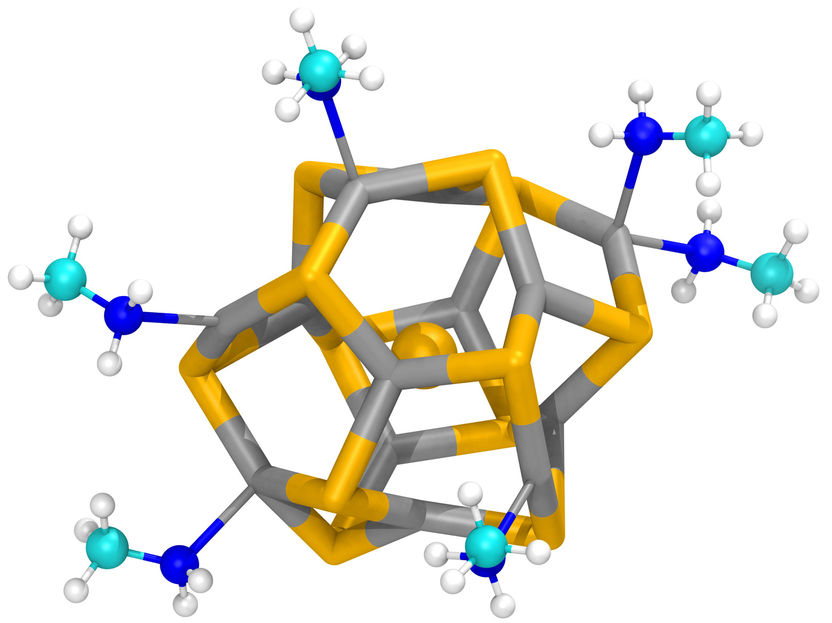Research on Semiconductors: Light Weakens Magic Nano Clusters
They are known as "magic sized nano clusters" because they have special properties: The particles consist of only a few atoms, but since they are arranged in a special crystal structure, they are extremely stable. Unless you expose them to light. Scientists from the Center for Nanointegration (CENIDE) at the University of Duisburg-Essen (UDE) have discovered that such materials undergo fundamental changes as soon as they are merely analysed using optical methods.

Model of a (CdSe)13 cluster (yellow/grey) surrounded by organic molecules (blue/white).
F. Muckel et. al., Nat Commun 11, 4127 (2020), CC 4.0
Junior professor Dr. Franziska Muckel is head of the working group "Electroenergetic Functional Materials" at the chair "Materials of Electrical Engineering”. Her team investigates cadmium selenide particles, which consist of no more than 26 atoms. Yet these atoms are arranged in a crystal structure, i.e. in a regular lattice similar to the symmetrical climbing frames made of ropes and metal on children's playgrounds. This structure renders the particles extremely stable.
In collaboration with the Seoul National University (South Korea) and the Max-Planck-Institut für Eisenforschung in Düsseldorf, UDE's researchers demonstrated that light above a certain wavelength weakens the bonds within these semiconductor nano clusters significantly – a hundred times more than in the same material with much larger dimensions.
Optical analysis methods as standard techniques in semiconductor research thus reach their limits in these dimensions: Instead of merely elucidating material properties, they change the investigated material itself. Since magic nano clusters are an important intermediate step on the way to larger functional particles, this is a decisive discovery.
Muckel, who conducts her research at the NanoEnergieTechnikZentrum (NETZ) on the Duisburg campus, now wants to put the results to practical use: "In the long term, we plan to develop components from similar materials that convert light into charge carriers and could therefore serve as optical sensors."
Original publication
Other news from the department science
These products might interest you

NANOPHOX CS by Sympatec
Particle size analysis in the nano range: Analyzing high concentrations with ease
Reliable results without time-consuming sample preparation

Eclipse by Wyatt Technology
FFF-MALS system for separation and characterization of macromolecules and nanoparticles
The latest and most innovative FFF system designed for highest usability, robustness and data quality

DynaPro Plate Reader III by Wyatt Technology
Screening of biopharmaceuticals and proteins with high-throughput dynamic light scattering (DLS)
Efficiently characterize your sample quality and stability from lead discovery to quality control

Get the chemical industry in your inbox
By submitting this form you agree that LUMITOS AG will send you the newsletter(s) selected above by email. Your data will not be passed on to third parties. Your data will be stored and processed in accordance with our data protection regulations. LUMITOS may contact you by email for the purpose of advertising or market and opinion surveys. You can revoke your consent at any time without giving reasons to LUMITOS AG, Ernst-Augustin-Str. 2, 12489 Berlin, Germany or by e-mail at revoke@lumitos.com with effect for the future. In addition, each email contains a link to unsubscribe from the corresponding newsletter.


























































